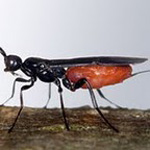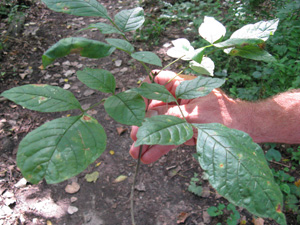Column: Seeds & Stems
Take a walk through Sunset Brooks Nature Area in Ann Arbor, and you’ll see the next generation of trees that in the past decade disappeared from the streets of the city.
Ash trees are sprouting up in nature areas and woods in and around the city, the successors of the green, white and black ashes we watched die in droves from an invasion of the emerald ash borer. Some of the new trees sprouted from ash trees, but larger saplings were probably just too small for the borers to bother with when the first invasive wave came through and destroyed the larger trees.
“For sure we’ve seen them in a lot of the natural areas,” says Kerry Gray, the city’s urban forestry and natural resources planning coordinator.
The Ann Arbor forestry crew spent at least three years doing nothing but removing ash trees, says Gray. Crews cut down an estimated 7,000 dead ashes along city streets and another 3,000 or so in parks and some nature areas, she says, at a cost of at least $2 million.
Many homeowners tried to save the trees in their own yards, to no avail. An estimated 30 million ash trees in southeast Michigan alone were wiped out.
The emerald ash borer lays its eggs in the bark of ash trees, and the larva proceed to eat the pulpy tissue just below the bark, in the layer that provides the pathway for water and nutrients to reach the branches and leaves of the tree. Soon, the trails of the borer larva effectively girdle the tree, killing it.
David Cappaert spent about seven years working on the emerald ash borer invasion – his home is just a quick walk from the Sunset Brooks Nature Area, which is located on the city’s north side, north of Sunset and south of M-14. Though he now works for a commercial greenhouse, every day he can see a testament to his work on his garage door: the silhouette of a parasitic wasp that bears his name, Atanycolus cappaerti.
The wasp, using its long ovipositor, drills through ash bark to lay an egg near an emerald ash borer larva. When the eggs hatch, they feed on the beetle larva, says Cappaert.
Whether the parasitic wasp exerts some control over the emerald ash borer will be “interesting,” he says. “I don’t predict it will keep (the beetle) under control, but you never know.”
Cappaert got involved in the emerald ash borer saga when the insect was first identified and several counties, including Washtenaw, were placed under quarantine – meaning that no ash wood could be taken outside their borders.
Michigan State University researchers set up shop at the University of Michigan’s Matthaei Botanical Gardens to conduct research on the insect, and they signed up Cappaert, an entomologist, to do some of the work.
What is now Atanycolus cappaerti showed up in ash trees at Seven Lakes State Park near Holly, Cappaert says.
It’s not that common to have a newly identified insect named for you, says Deborah McCullough, professor of forest entomology at MSU and the go-to researcher on the emerald ash borer. But Cappaert is the reason that the parasitic wasp was finally identified. “He leaned on the taxonomy guy to get it identified,” she says. And now that researchers know what they’re looking for, she says, “we’re finding this parasitic wasp in a number of places now.”
Cappaert says that besides Atanycolus cappaerti, two other likely killers of the emerald ash borer have been found in Ohio, and there could be more.

Atanycolus cappaerti, a parasitic wasp that feeds on emerald ash borer larva, is named after David Cappaert, an Ann Arbor entomologist. (Photo courtesy of David Cappaert.)
Will parasitic wasps someday wipe out the emerald ash borers? Cappaert doesn’t think so. Probably the emerald ash borer will continue to be in the environment, since there are always new ash trees around. But it may reach equilibrium either because there are not a lot of ash trees to eat or because of enemies such as Atanycolus cappaerti.
The destructive emerald ash borer invasion first appeared in southeastern Michigan, and studies have found traces of the pest dating back to the early to mid-1990s. Now the borer has moved on, spreading to 14 states and Canada, with its farthest reach so far in Minnesota, New York and Kentucky, as well as Quebec.
Though I had hoped that every last emerald ash borer had moved on from this area, that’s not the case, says McCullough. Research by McCullough and her students show there still are emerald ash borers in the neighborhood, but studies aren’t sure how many. The insects “probably will never be gone completely – at least not for a long, long time,” she says.
And though Ann Arbor might not have many more ash trees to lose, the emerald ash beetle is not far away. The beetle population is very much at or near its peak in the Lansing and Grand Rapids areas, says McCullough.
One positive result of the years of researching the emerald ash borer is that there now is a protective treatment for ash. Emamectin benzoate, marketed under the name TREE-äge (pronounce triage), must be applied by professionals. The root-injected treatment was developed only two years ago but seems to be nearly 100% effective for at least that long, says McCullough.
I remember writing stories about the emerald ash borer invasion for The Ann Arbor News, and one of the most interesting things about the story was how scientists responded to the insect’s invasion. It was known primarily in Asia and somehow was imported into this country, probably on packing material.
At first, there was little information on the bug – only a taxonomic description and a few paragraphs in Chinese (the emerald ash borer is native to China, Korea, Japan, Mongolia, Taiwan and eastern Russia).
Researchers had to find out the bug’s life cycle – when the borers fed, mated, laid eggs and emerged from the trees. Did the emerald ash borer overwinter – that is, did they stay alive through the winter? (Some larva did.) Would the insects lay eggs in any trees besides ash? (They don’t seem to.) Why does the emerald ash borer exist with some native ash trees in China? (Good question.)
At the outset, researchers brought in pieces of infected ash bark to identify emerald ash borer eggs. But at that point, they didn’t even know what the eggs looked like, and the ash bark has “all kinds of weird stuff,” McCullough said. “Eventually, we figured it out,” she says.
Scientists also figured out how to build effective traps. They found that emerald ash borers were attracted to purple and to stressed trees. They measured volatile gases given off by the ashes. They girdled trees and counted bugs.
“We did some fun stuff,” says McCullough. She does admit that there were some not-so-fun times – stomping through poison ivy, sweating through top summer temperatures and slapping bugs.
After all these years, McCullough says she’d still like to know how the beetles choose which ash tree to infect. “Why do beetles fly past really good host trees?” she asks.
Another problem is how to tell if the emerald ash borers have already infected an ash. It can take a year or longer for an infected tree to show signs of dying, and it’s not so easy to see the emerald ash borers flying around. “They’re up in the tops of the trees,” says McCullough. “They’re fast, and they’re little.”
Researchers are still working on the problem, she says. “We want to model how the population spreads, so we can predict where the beetle is,” says McCullough. In the past, she says, “we were always trying to catch up with the beetle.”
Though any new findings are too late to save the thousands of dead ash trees removed in Ann Arbor, the story’s not done. McCullough and others studying the problem are fielding calls from places that are only now seeing the first signs of the destructive insects.
And Gray is keeping an eye on it from Ann Arbor. “We’re kind of all waiting to see what will happen,” she says.
A Second Chance for Would-Be Conservation Stewards
In my April column, I wrote about the Michigan Conservation Stewardship Program in Washtenaw County, a 40-hour course on environmental issues for the public. The program, hosted by the county’s Extension Service, lines up a variety of speakers over two months to introduce ecological issues through talks on wetlands, forests, grasslands and other natural resources.
The course was planned for the spring but postponed until this fall because of a shortfall of enrollees. The course is now scheduled to start on Saturday, Sept. 11, with an introductory class lasting a full day. After that, classes will meet every Wednesday from 6-9 p.m. beginning Sept. 15 and ending Nov. 3, with two additional all-day meetings on Saturday Oct. 9 and 23.
Sometimes participants will be up to their waders in a stream or foraging for plants along a railroad track. Everyone will have to do 40 hours of conservation-related volunteer work before graduating. Last year, projects included surveying parkland and installing a native plants garden.
The course costs $250, which is due by Sept. 2. You can get an application and brochure online or at the extension office, 705 N. Zeeb Road. If you have any questions, call Bob Bricault at 734-997-1678.
If you’re interested in knowing more about how the environment works, this is the course to take.
About the writer: Marianne Rzepka, former reporter for the Ann Arbor News and Detroit Free Press, is a Master Gardener who lives in Ann Arbor and thinks it’s fun to turn the compost pile.







Over time, predators and prey tend to arrive at an equilibrium (if the predator wipes out all its prey, it dies … an explosion of prey is a self-correcting boon for the predator population). Back in the 1950s, rubber plantations were losing a moderate percentage of their expected production to a bark borer. There response was DDT spraying, which resulted in an explosion of bark borer damage, more spraying, and denuded rubber tree plantations. Seems that there was a wasp that feasted on the bark borer and kept its population in check. The DDT got only the borers near their entrances through the bark. The wasps fed on them and died of DDT poisoning. The population of the better hidden borers, freed from a predator more efficiently deadly than the DDT, killed more trees than they were ever able to do prior to spraying.
Way cool! Congratulations to my neighbor Dave. And maybe my “tree guy” isn’t so crazy, telling me to let ash seedlings grow. After all, I still have a couple of American elms.
This is the first I have heard about the Tree-age treatment. I have an ash tree which has survived the onslaught, and that I would consider treating.
Does anyone have any experience with this, including recommendations for arborists in Ann Arbor who use it?
Anyone wanting an Arborist to treat from Emerald Ash Borer can contact your local cooperative extension service office or use the International Society of Arboriculture website for names of ISA Certified Arborists in your area that can offer Tree-age injection service.
Minor point. Trees are infected by diseases and infested by insects like the Emerald ash borer.
Emerald Ash Borer is just one of many exotic pests that have found their way to the US, generally on trade goods. Once in the country, forest pests are spread rapidly by people moving firewood. The Pest Tracker web site provides information about hundreds of exotic pests that have been introduced or are highly likely to be introduced to the US.
The picture (leaves of an ash tree) provided in the this article was was the only one of many web images that helped me id the many ash seedling in my yard in west central WI. Thank you. I will let them grow — our extension service is a few miles away.
This article was very helpful and instructive. Everyone in the area is calling these seedlngs box elder. With its yellow-gold fall color, I knew it couldn’t be box elder I HAVE a box elder. I wish that someone could find a wasp to take care of the area’s gypsy moth infestation.